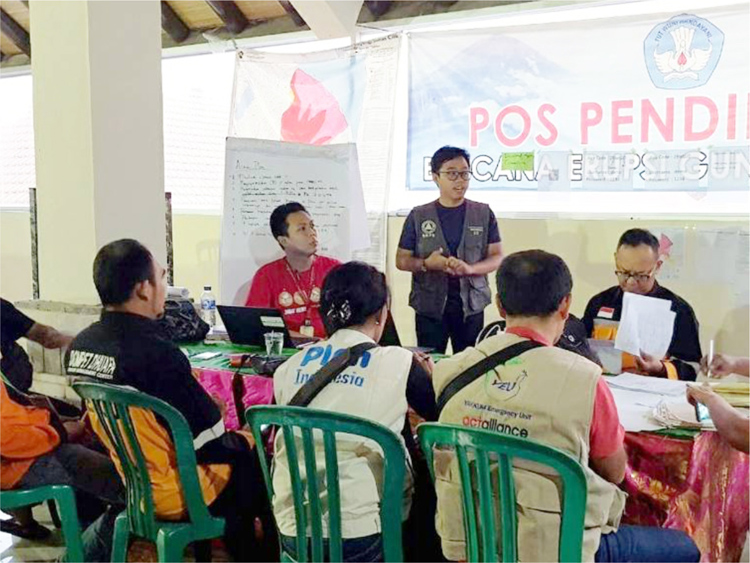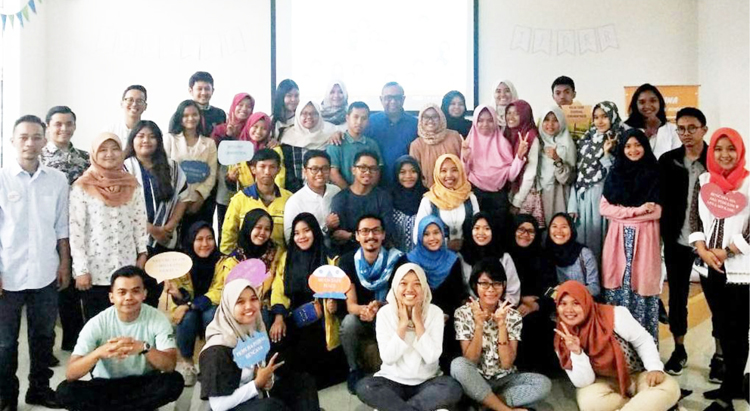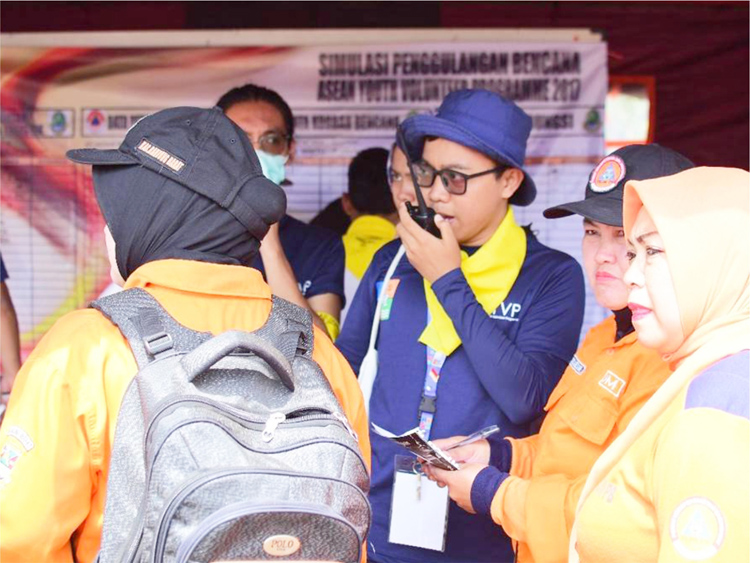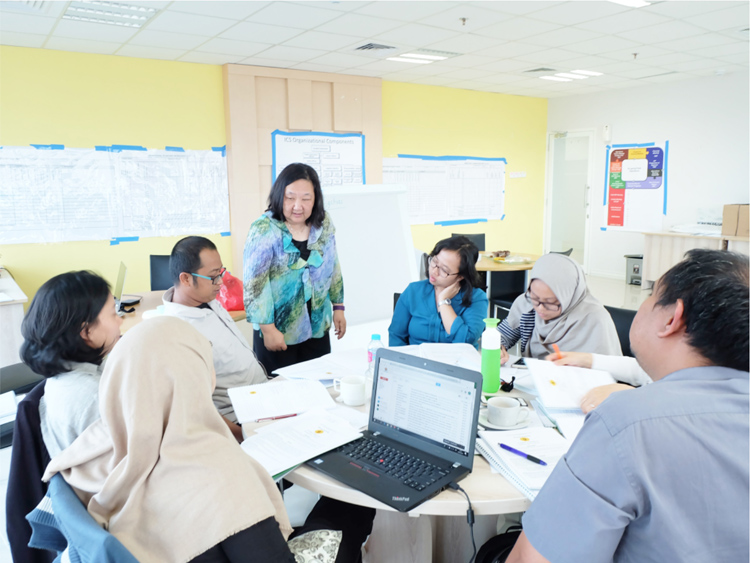Vol 37-Fajar Shidiq

Fajar Shidiq
Co-Founder & Chairman, Indonesian Youth on
Disaster Risk Reduction
THE INDONESIAN YOUTH ON DISASTER RISK REDUCTION (IYDRR) FORUM BEGAN TO TAKE SHAPE IN 2015, AS A GROUP OF JAKARTA UNIVERSITY STUDENTS PARTICIPATING IN DISASTER MANAGEMENT ACTIVITIES RECOGNISED THE NEED, AND THE OPPORTUNITY, TO INCREASE THE ALL-IMPORTANT ENGAGEMENT OF YOUTH THROUGHOUT DISASTER MANAGEMENT PRACTICES. IYDRR’S CO-FOUNDER AND CHAIRMAN, FAJAR SHIDIQ, SPOKE TO THE AHA CENTRE ABOUT HIS EXPERIENCE IN EXPANDING THIS STRATEGIC AND MODERN MOVEMENT.
“We all kept meeting at disaster management events– it was like ‘you again, you again,’–always the same people,” Fajar recalls of his participation in disaster management activities during his early university days. “In 2015 we started discussions about creating something more formal and united, and in late 2016 IYDRR was established.”
While still relatively new, the organisation has already begun to engage strongly with the wider national disaster management movement, and even dipped its toes into regional and international circles. However, Fajar highlights the importance of developing a strong presence locally, as the organisation continues to advance its presence within the Indonesian disaster management sector. Youth were traditionally more engaged in response efforts, as volunteers. However, with more recent inclusion in other disaster management aspects–such as policy development and decision-making–such youth groups starting to gain more opportunities to engage. Examples of this increase include the engagement of youth within the ASEAN-ERAT Induction Courses, with the AHA Centre recognising the importance of youth participation within One ASEAN, One Response efforts.
Fajar sees a variety of positive elements for increased youth engagement within overall disaster management processes. The range of backgrounds and skills offered by youth organisations, such as IYDRR, can be of great benefit for the disaster management sector. Members are studying, or hold degrees, from a wide range of study areas, all of which can be valuable within disaster management efforts. Such a context opens the door for organisations such as IYDRR to provide great value within its key working areas of capacity development, advocacy and community empowerment, and for the voice of youth to be commonplace within all aspects of disaster management. “This is what we are pushing for, slowly of course, but to have a stronger engagement in all aspects of disaster management. We want the youth to have a voice.”
While the organisation works with extremely limited funding and relies heavily on the passion and time provided by its more than 100 members, a range of achievements have already begun to appear. Fajar highlights the design of infographics–and ultimately the use of these tools after the 2018 Jakarta earthquake–as a key example of what was perhaps considered a small and unimportant activity holding great final value. “After the earthquake these infographics were being shared everywhere–people were contacting us and requesting we send them,” he recalls. It is such outcomes that IYDRR hopes to replicate and expand, with an aim to develop a range of tools to support disaster risk reduction and response for communities, particularly in urban areas. “When you look at the SDGs, it’s clear urban areas are high-risk” he comments. “This is an area that needs to be strengthened, and therefore we want to focus heavily on supporting such efforts.” In the era of technological advancement, coinciding with unprecedented growth in technological use, such efforts fit perfectly with the skills held by youth organisations such as IYDRR.
As the organisation becomes increasingly engaged within the national, regional, and even international disaster management field, Fajar hopes that the importance, value, and capacity of youth will also be increasingly recognised, accepted and used to advantage by all stakeholders within the sector. “If you provide space for youth, provide opportunity, they may do something that you never imagined possible.”
Written by : William Shea | Photo: AHA Centre, IYDRR
- Published in The Other Side
Vol 38-Incident Command System and Incident Action Planning Workshops

INCIDENT COMMAND SYSTEM
AND INCIDENT ACTION PLANNING WORKSHOPS
JAKARTA, 16-27 APRIL 2018
During April 2018, the AHA Centre, with the support of the United States Forest Service (USFS), successfully conducted intensive trainings regarding the Incident Command System and Incident Action Planning.
The Incident Command System (ICS) model, first developed in the 1970s in the aftermath of wildfires in California and Arizona, encourages the use of a standardised management system to enable a synergised inter-agency collaboration when responding to an emergency. To date, ICS has been developed and adjusted to address various complexities and types of emergency responses, including during the first attack of the World Trade Centre in 1993. Alongside this, ICS is also applicable for managing non-emergency situations – such as public events which attract massive crowds – including sporting events, annual festivals, parades and concerts.
While ICS covers the basic principles of cross-sectoral coordinating mechanisms, Incident Action Planning (IAP) provides in-depth knowledge for the planning department of the AHA Centre whenever a need for disaster-response arises. The IAP trainings involved
case studies in which the AHA Centre’s staff were challenged to practice their skills, use their creativity, and draw on their knowledge to develop strategies to address various disaster scenarios, including landslides, floods, and fires. The evolving scenarios required continuous efficient response plans, factoring in analysis from available resources, logistical aspects, and also safety and security.
Both ICS and IAP have been adapted and utilised by the AHA Centre since its establishment as the coordinating agency for humanitarian assistance in Southeast Asian region. The dynamic nature of ICS has been effective for the Centre’s emergency operations, due to its flexibility and adjustability to suit a range of responses. The ICS system has also been adapted and is currently used by five ASEAN Member States, creating coordination and a common ground for the ever-growing regional collaborations in managing disasters.
Written by : Shintya Kurniawan | Photo : AHA Centre
- Published in AHA Centre Diary 2
Vol 39-PREDIKT Team

PREDIKT TEAM
Disaster awareness and preparedness forms a key element within overall disaster management efforts, supporting significant decreases in severity of disaster impact on affected communities. While there is a vast array of science and knowledge behind awareness and preparedness, there remain many challenges in communicating such knowledge to a vast and diverse communities across the ASEAN region. Developing engaging, child and family-friendly tools for communicating disaster awareness and promoting preparedness is the defining element behind the creation of PREDIKT – the Preparedness for Disaster Toolkit – a unique and innovative toolkit designed by a group of young Indonesian change-makers. One of PREDIKT’s designers, Avianto “Anto” Amri, spoke to The Column about this innovative and interesting project.
The idea for PREDIKT came about due to the designer’s personal experiences of a lack of family-friendly information and tools for disaster awareness and preparedness in the home – particularly to support parents and their children on learning about disaster preparedness together. As many children are at home when disaster strikes, in-home learning forms a key element of overall disaster preparedness efforts, and empowers children and their families with the knowledge of what must be done should they face a disaster.
Initially, as part of his PhD studies, Anto designed a family disaster preparedness plan in the form of poster guidance cards that allowed children and their parents to learn essential steps for ensuring preparedness within their homes. Based on positive testing results, Anto teamed-up with Tasril “Iriel” Mulyadi (designer) and Wahyu “Billie” Minarto (child safety expert), to further develop and then submit
the toolkit to a Flood Resilience Innovation competition organised by the International Federation of the Red Cross/Red Crescent Societies (IFRC) and Zurich Insurance – a competition in which their innovation took out first place. This was followed by the team proposing for, and being awarded a grant for the toolkit through the United States Government-sponsored Young Southeast Asian Leaders Initiative (YSEALI) Seeds for the Future programme, and with the addition of another team member – Meliza “Liza” Rafdiana – PREDIKT hit the ground running.
PREDIKT itself is formed by a set of board games and physical learning materials that form a fun and hands-on way for children and their parents to learn about disaster preparedness at home. As the ASEAN region continues to modernise, many such tools have moved to online and electronic platforms – yet PREDIKT chose to focus on a more traditional, physical style. As stated by Anto, online platforms still face significant limitations within a rapidly developing ASEAN community.
“We wanted to create something offline because we know that there are still many places in Indonesia as well as in many ASEAN countries that do not have access to internet or even electricity.”
– Anto explains.
Here-in lies the inclusiveness and accessibility of the PREDIKT format. The team also aims to facilitate a fun and interactive atmosphere for the entire family, allowing children to engage with their parents and ask questions related to disaster preparedness.
The toolkit bases itself on five key elements, all of which add-up to form the reason for its attractiveness and functionality. PREDIKT has been developed to be easy to understand, using child-friendly wording and visual elements, and also aims to motivate children to discuss preparedness with their family. The toolkit always aims to remain affordable, alongside its offline status to ensure access for any family regardless of their situation. Finally, PREDIKT aims to be expandable, allowing it to be further developed to encompass a range of other relevant elements related to disaster hazards and preparedness functions. This expansion forms a key facet of PREDIKT’s plans for the near future. Currently focusing on 5 specific disaster hazards, the team is in the process of expanding the toolkit to cover a wider range of disaster content. Alongside this, they are also working
institutions to increase the toolkit’s inclusivity – with particular focus to children with visual impairments or other disabilities. Not disregarding the importance of online presence, PREDIKT also plans to focus towards building and strengthening their website as an online hub for child-friendly disaster preparedness information sharing.
As for the response, so far PREDIKT has received great praise – particularly from users themselves. “We continue to be amazed with the reactions of parents who have played PREDIKT”, says Anto. He recalls a mother who was particularly excited by the toolkit’s ability to allow her children to learn as they play. “She was excited that finally her children would take their eyes off their gadgets to engage with her in learning and games”. “It’s like taking a course on disaster preparedness, minus all the boring parts” says Anto as he quotes another response from a happy mother. The variety of positive responses continue to display the value in the engagement of children, as well as their desire to ask questions and learn more. These responses evidence the importance and aims of PREDIKT itself, as concluded by Anto when he stated that “PREDIKT really does fill the gap for children to learn, together with their parents, about disaster preparedness in a fun and interactive way”.
Written by : Shintya Kurniawan | Photo : AHA Centre, PREDIKT
- Published in The Other Side
Vol 39-Monthly Disaster Review and Outlook

MONTHLY DISASTER REVIEW AND OUTLOOK
MAY 2018 | DISASTER MONITORING & ANALYSIS
(DMA) UNIT, AHA CENTRE
GENERAL OVERVIEW OF MAY 2018
Hydro-meteorological hazards continued to form a majority of disasters within the ASEAN region during May 2018. Using yearly data comparisons, it is evidenced that the ASEAN region experienced twice as many disasters when compared to the same time period last year. Data for the initial three weeks of the period showed low numbers of recorded disasters. However, numbers increased significantly as Tropical Depression 5 developed and moved across Sulu Sea and into the South China Sea. This situation resulted in flooding, storm surges and strong wind events across Indonesia, the Philippines, Malaysia, Brunei Darussalam and Viet Nam. Monsoon season has begun in areas within proximity of the Indian Ocean, which creates increased flood risks for northern Myanmar along the Irrawaddy basin. This is consistent with ASEAN Specialised Meteorological Centre’s (ASMC) observation of the end of the dry season on the 16th of May, marked by an increase in shower activities across the northern part of the ASEAN region.
There were 37 moderate earthquakes with magnitudes of > M .4.0 felt in Indonesia and the Philippines, which were observed at around II to IV MMI. Despite the magnitude of such events, no casualties or damage was reported as a result of earthquakes in both countries. As of the end of May, the alert status for volcanoes in Indonesia are as follows – Warning Alert (Awas, the highest of 4 levels) for Mount Sinabung in North Sumatra; Watch Alert (Siaga, second highest) for Mount Agung in Bali; and Cautionary Alert (Waspada, a level 3 alert) for 19 other volcanoes across the nation. Despite its Cautionary alert level, Mount Merapi in Central Java, Indonesia, has experienced significant increased activity recorded on the mountain, with phreatic eruptions and release of volcanic ash columns beginning on the 21st of May. Three eruptions at the end of Week 22 (1st of June 2018) forced two airports in Central Java to temporarily shut down their operations as a result of the ash plume.
OUTLOOK FOR JUNE-JULY 2018
According to the ASMC, wet weather conditions are expected over the northern parts of the ASEAN region for the rest June, with more shower activities forecast as the transition to the Southwest Monsoon is expected to begin during the month. Rainfall can be expected to increase during this time due to the presence of the monsoonal rain band across the north of the ASEAN region. The Southwest Monsoon season typically prevails over the region between June and October, and is associated with the traditional dry season in southern parts of ASEAN contrasting with the wet season in northern parts of the ASEAN region.
In stark contrast to the northern ASEAN region, extended periods of dry weather can be expected during June and July in the southern reaches of ASEAN. This may lead to an escalation of hotspot activities, with smoke plumes should ignition occur, particularly in parts of Sumatra and Kalimantan. Slightly below-normal to near-normal rainfall may still occur over most parts of the region during this period, with below-normal to slightly below-normal rainfall expected for Java, Nusa Tenggara and Timor Leste during the early part of the Southwest Monsoon season.
As always, you should keep posted on weather updates from your respective Meteorological Services and Disaster Management Organisations for evacuation notices (if any). You can refer to our social media for links to the respective national agencies and organisations for further information.
Written by : Mizan Bisri, Qing Yuan Pang
DISCLAIMER
AHA Centre’s estimation is based on data and information shared by National Disaster Management Organisations (NDMOs) and other relevant agencies from ASEAN Member States, international organisations and news agencies. Further information on each recorded-significant disaster, description and details of data and information are available at: http://adinet.ahacentre.org/reports.
- Published in Monthly Disaster Outlook











